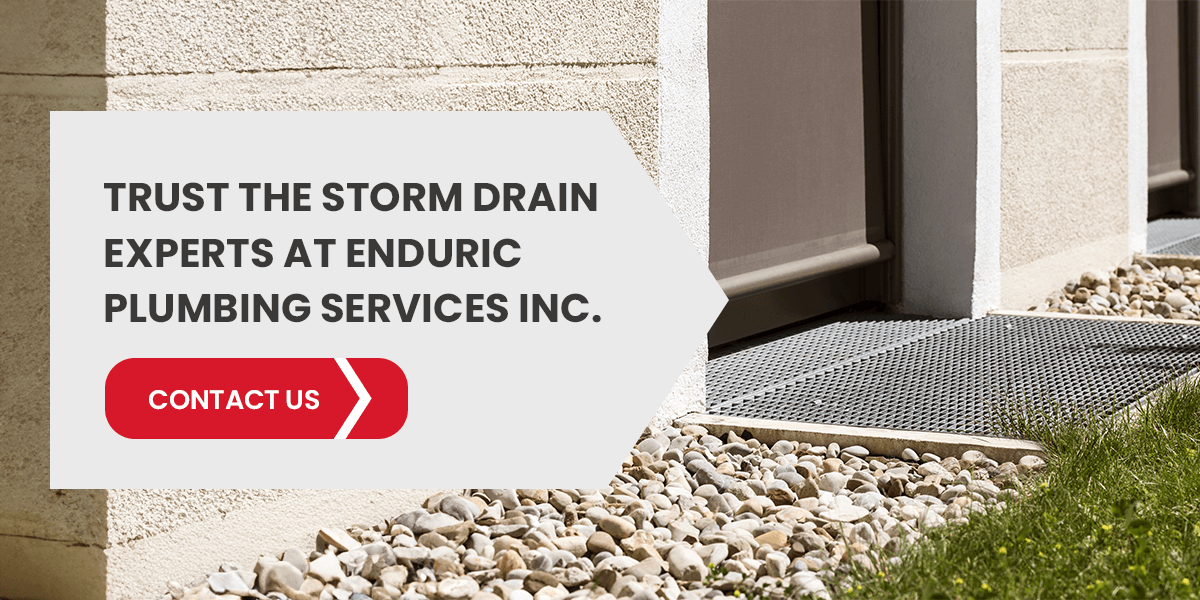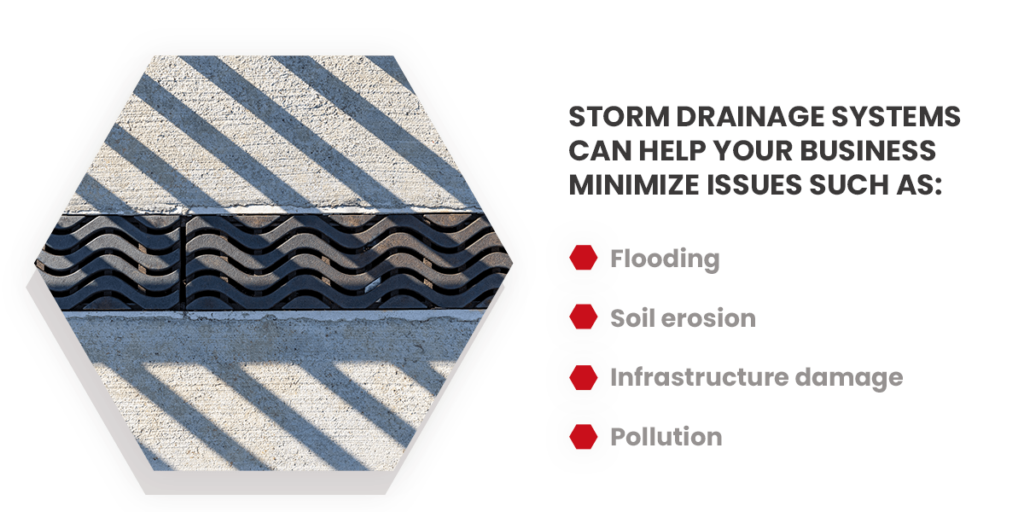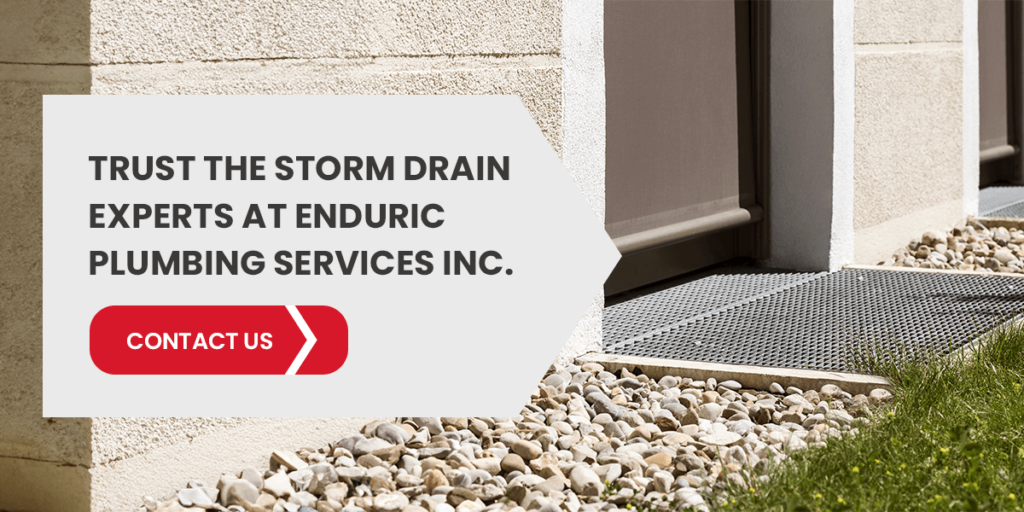
November 12, 2024
Protecting your commercial property depends on the effectiveness of your stormwater drainage system. How well your drains manage and divert water determines your business’s safety and flood risk. With the right storm drain on your property, you can preserve buildings, structures and landscaping.
Importance of a Storm Drainage System
Storm drainage systems are key to protecting your property and complying with environmental regulations. They can help your business minimize issues such as:
- Flooding: A well-suited drainage system for your property’s needs can protect your buildings and landscaping from flooding. Efficient rainwater management enables your business to channel water even during extreme weather.
- Soil erosion: When water pools in one place for a long time, it can cause soil to erode. Drainage systems help water flow freely to minimize erosion and protect landscaping.
- Infrastructure damage: Excess moisture can lead to various types of damage, from foundational problems to mold growth. Pooling water can also freeze in colder temperatures, causing additional damage to your building and outdoor spaces.
- Pollution: Stormwater can contain multiple pollutants, including bacteria, pesticides and oils. A drainage system helps control pollution levels to keep water cleaner and safer.
Finding the right type of stormwater drainage system for your specific property is critical. The proper system for your business will depend on factors such as:
- The local area’s storm frequency and severity.
- Your property’s soil type.
- Existing drainage system.
- Structures on your property, including buildings, parking lots, walkways or loading zones.
- Nearby slopes or hills.

5 Different Types of Storm Drains
Specific stormwater drainage systems work excellently for heavy rainfall, while others do better with light precipitation. Likewise, certain drains can handle foot and vehicle traffic, while some suit only a distinct soil type.
Learning about the different types of stormwater drains and where they work best can help you find a practical solution for your drain management requirements.
1. Trench Drains
A trench drain is a long, narrow channel that diverts surface water away from an area into a specified outlet, like a sewage system. The trench is covered by a slotted grate, usually made of plastic, metal or concrete, to prevent debris from entering and blocking the drain. This type of storm drain is ideal for removing water that tends to pool around structures or in open spaces, such as loading areas or parking lots.
Trench drains enable you to control surface water drainage around your property to minimize flooding risks. They can redirect water away to create safe, dry and usable outdoor spaces for your business. They are versatile systems that work well in various settings, such as warehouses, factories, parking lots and other commercial buildings.
2. Catch Basins
Catch basins also direct surface water runoff away from paved surfaces and landscaping. Water pours through a grid, grate or filter and enters a filtration tank before flowing through pipelines. The grate keeps large debris out of the system, while the tank allows dirt, grime and other pollutants to settle so clean water can continue to move through the pipes. The large tank also enables catch basins to handle high water volumes.
You may consider using catch basins on your property if you have low-lying areas in parking lots or lawns where water tends to pool and become stagnant. The catch basin can minimize pollution and flooding on your property and prevent soil from becoming soggy, stinky and full of bacteria.
3. French Drains
Similar to trench drains, French drains help direct water away from the foundation of your building. Instead of removing surface water as a trench drain does, French drains manage groundwater and divert excess moisture in the soil away from structures. These drain types are ideal for areas with heavy rainfall because they can manage large volumes of water quickly and efficiently. They are not as effective in areas with light precipitation.
French drains have small grates around the foundation of a building that connects to long pipes that carry water away. The pipes can be covered with aesthetically pleasing features such as plants, pebbles or grass. Decorative grates are also common for these drains.
4. Slot Drains
A slot drainage system uses one or more long, thin drain slots with catch basins underneath. These slim openings allow water to pass through while preventing most types of debris from entering the system. They are also low maintenance and easy to clean.
Slot drains can be driven and walked on, but they can flood easily, so they are best used in outdoor areas that do not need excessive drainage. They can also be combined with other solutions to increase their capacity. Without a grate, slot drains have a low profile that minimizes tripping hazards, allows for wheeled traffic and maintains surface appearances.
5. Ditches and Swales
These drainage options are open-channel systems designed in a V-shape to move water away from your property as quickly as possible. They also aid in redirecting water away from roads and other paved surfaces. Swales are engineered with specific requirements for soil, slope and bottom width to help direct water and filter pollutants.
Ditches and swales are often lined with vegetation or gravel to help slow water flow and allow it to absorb into the ground. They are easy to clean but require continual maintenance to ensure they perform optimally.
Trust the Storm Drain Experts at Enduric Plumbing Services Inc.
When you need expert drainage solutions to protect and preserve your commercial or industrial property, come to Enduric Plumbing. Our professionals are trained to handle various commercial plumbing issues, including stormwater management. We can assess your needs and recommend solutions that suit your situation. Our team can also select and install a drainage solution that is appropriate for your property.
Let our crew handle your stormwater drainage needs while you focus on running your business. Contact us for your storm drain needs, including installations, repairs and maintenance.



